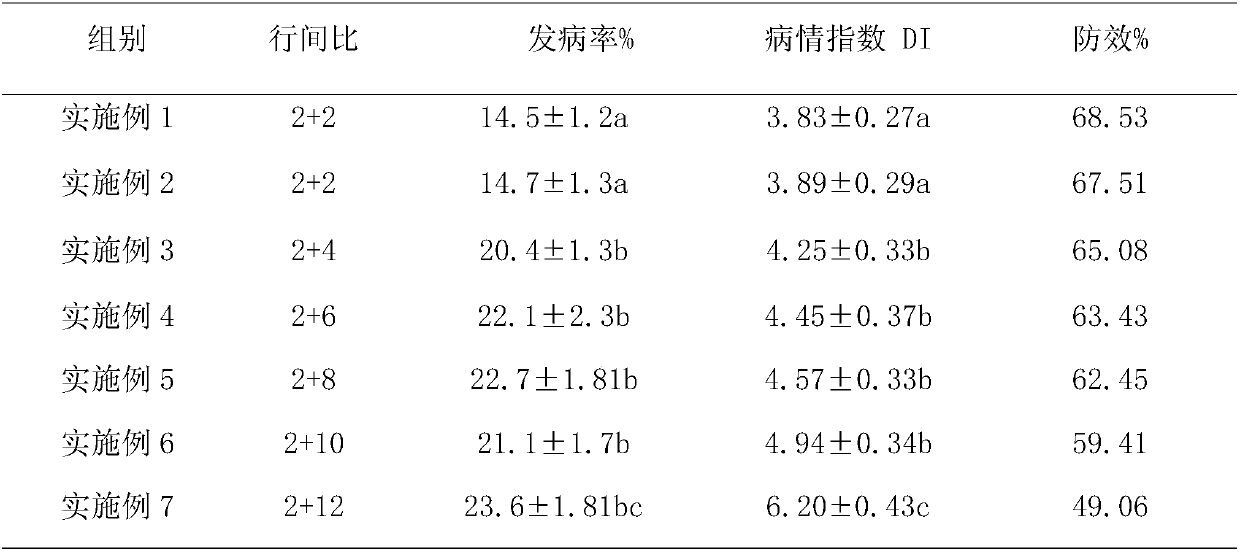Green planting method for controlling diseases and insect pests in rice field
A planting method, technology of pests and diseases, applied in the field of plant cultivation, to achieve the effect of increasing the quantity, high economic benefit, and reducing the amount of pesticide use
- Summary
- Abstract
- Description
- Claims
- Application Information
AI Technical Summary
Problems solved by technology
Method used
Image
Examples
Embodiment 1
[0025] (1) Select tall stalk rice as the intercropping variety, and select dwarf variety for hybrid rice. Tall-stalked varieties are 20 cm taller than short-stalked varieties, and the maturity period is basically the same, no more than 10 days before and after.
[0026] (2) Dwarf varieties are cultivated in the conventional row planting method. The plant spacing, row spacing and density are the same as the conventional method, and the planting density is the same. The inter-row plants are 23.3cm×23.3cm, 3 plants per hole, and the density of mountain bar rice is 3,000 holes. / 667㎡, about 13,600 holes / 667㎡ for hybrid rice; the total number of holes for paddy field plants is controlled between 16,700 holes / 667㎡, and transplanting is carried out according to the row ratio of mountain bar rice: hybrid rice = 2:2. That is to keep the current cultivation method of hybrid rice unchanged, and plant 2 more rows of high-stalk mountain bar rice varieties every 2 rows in the hybrid rice fi...
Embodiment 2
[0029] (1) Select tall stalk rice as the intercropping variety, and select dwarf variety for hybrid rice. Tall stalk varieties are 30 cm taller than short stalk varieties, and the maturity period is basically the same, no more than 10 days before and after.
[0030] (2) The dwarf varieties are cultivated in the conventional row planting method. The plant spacing, row spacing and density are the same as the conventional method, and the planting density is the same. The inter-row plants are 16.7cm×16.7cm, 5 plants per hole, and the density of mountain bar rice is 4,000 holes. / 667㎡, about 14,000 holes / 667㎡ for hybrid rice; the total number of holes for paddy field plants is controlled at 17,000 holes / 667㎡, and transplanting is carried out according to the inter-row ratio of mountain bar rice: hybrid rice = 2:2. That is to keep the current cultivation method of hybrid rice unchanged, and plant 2 more rows of high-stalk mountain bar rice varieties every 2 rows in the hybrid rice f...
Embodiment 3- Embodiment 10
[0033] Each operation in embodiment 3-10 is all identical with embodiment 1, and difference is, the inter-row ratio of mountain bar rice and hybrid rice in embodiment 3 is 2:4, and the inter-row ratio of mountain bar rice and hybrid rice in embodiment 4 It is 2:6, and the inter-row ratio of rice in mountain fence and hybrid rice is 2:8 in embodiment 5, and the ratio between rice in mountain fence and hybrid rice in embodiment 6 is 2:10, and in rice fence in embodiment 7 and hybrid rice The inter-row ratio is 2:12, and the inter-row ratio of the mountain hurdle rice and the hybrid rice in embodiment 8 is 2:14, and the inter-row ratio of the mountain hurdle rice and the hybrid rice in the embodiment 9 is 2:16, and the middle hurdle rice in the embodiment 10 is 2:16. The inter-row ratio of rice and hybrid rice was 2:18.
PUM
 Login to View More
Login to View More Abstract
Description
Claims
Application Information
 Login to View More
Login to View More - R&D
- Intellectual Property
- Life Sciences
- Materials
- Tech Scout
- Unparalleled Data Quality
- Higher Quality Content
- 60% Fewer Hallucinations
Browse by: Latest US Patents, China's latest patents, Technical Efficacy Thesaurus, Application Domain, Technology Topic, Popular Technical Reports.
© 2025 PatSnap. All rights reserved.Legal|Privacy policy|Modern Slavery Act Transparency Statement|Sitemap|About US| Contact US: help@patsnap.com



